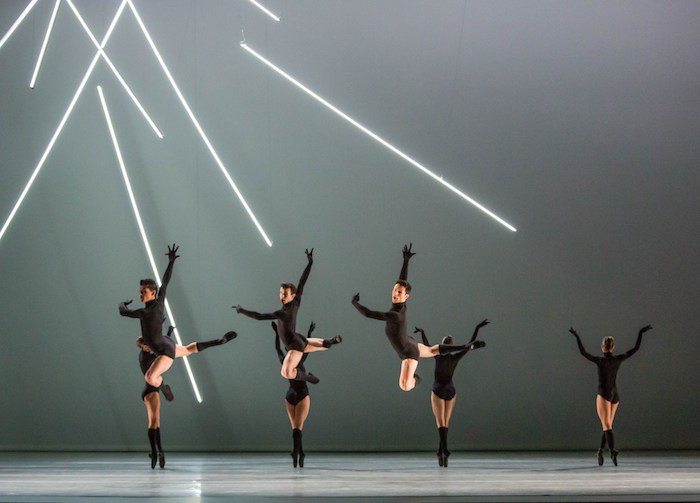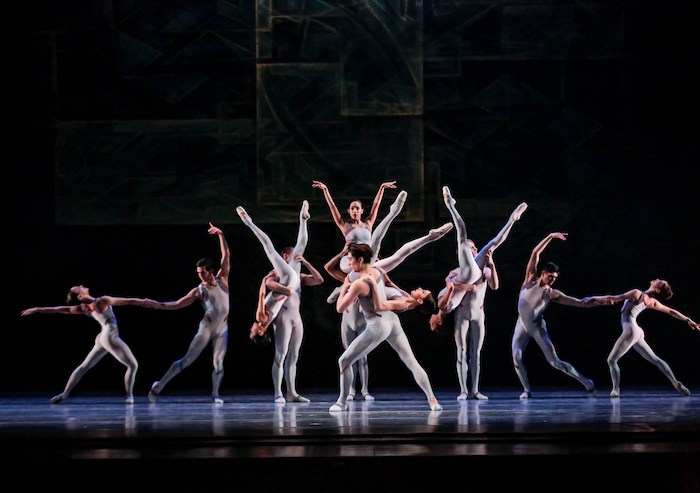International colloquium in dance and performance studies addresses issues of race and racism in American classical ballet
The beauty and artistry of ballet can belie the sometimes painful truths that exist behind the dance.

Calvin Royal III and Unity Phelan in George Balanchine’s “Agon” (1957), Vail International Dance Festival 2018. Restaged by Heather Watts. Photo by Eric Baiano.
“Those dances by George Balanchine and other 20th-century neoclassical choreographers reveal how the idiom of classical ballet has institutionalized and subverted American racism,” said Ninotchka D. Bennahum, a professor of dance and performance studies at UC Santa Barbara.
These ballets — such as the iconic, Civil Rights-era Balanchine ballet “Agon” from 1957 — reveal the complex relationship ballet and preeminent cultural institutions share with racial consciousness in the United States before and after World War II, she added. “Dance artists asked to undertake these roles have the capacity, the moral responsibility to shift our consciousness or to raise our consciousness. No work of art belongs solely to its time,” Bennahum said.
These topics and others will be considered when distinguished scholars and world-class performers gather Monday, April 29 in UC Santa Barbara’s ballet studio for the colloquium “Race, Ballet, American Dance,” a day of discussion and demonstration. Co-curated by Bennahum and Stephanie Batiste, an associate professor of English and of Black studies, the conference is the inaugural event of the International Colloquium for the Study of Dance and Performance Studies.
“We will pose the question, ‘What is the value of these actual works of ballet as historical archive?”
Combining elements of live performance and music, discussion and filmography, the multidisciplinary colloquium — which is free and open to the public — will explore the critical role of art in capturing and commenting on American history, specifically examining how racism has been institutionalized in American classical ballet.
“The history of the civil rights movement is written by ballet choreographers and modern choreographers,” said Bennahum. “Dancing bodies play a vital role in getting audiences, in raising public awareness to issues of injustice, to issues of joy and love and sexuality, and things that are not so easy to articulate with words.
“But these are not happenstance dances, these are dances that happened in very particular moments of time,” she added. “The relationship between African American vernacular dance, African American choreographed ballet and Russian, British, American ballet, really became a symbol of race relations in the United States.”
Participants will enter the event through a lobby exhibition featuring an archival collection of photographs curated by Bennahum from the Jerome Robbins Dance Division of The New York Public Library, the largest and most comprehensive archive in the world devoted to the documentation of dance.
“I really feel that it’s very important for students that we show them dancing bodies they cannot see in Santa Barbara,” Bennahum said. “The gravitational center of dance in the world is New York and I just felt we had to bring it to them, and we had to bring it in the form of performance and in the form of art exhibit, images on the walls, so they see that this is an intellectual, academic subject they can study. But it cannot happen without performance because without that the archive is missing. You have to have a sense of the geography of the stage. For these kids learning to dance, to know and feel their way through history, kinesthetic awareness is really significant.”
Further to that end, the colloquium’s featured guests include Heather Watts, former principal dancer of New York City Ballet and a distinguished lecturer, who will present and stage two seminal works: George Balanchine’s “Agon,” with music by Igor Stravinsky, and Jerome Robbins’ “Afternoon of a Faun,” with music by Claude Debussy. The pieces will be danced by Calvin Royal III (principal dancer, American Ballet Theatre) and Unity Phelan (soloist, New York City Ballet), accompanied by New York City Ballet Orchestra pianist Cameron Grant.
“In different ways, at their premieres both Balanchine’s “Agon” (1957) and Robbins’ “Afternoon of a Faun” (1953) addressed issues of race,” said Watts. “I’m looking forward to sharing and examining these works at the colloquium, focusing on their impact felt not only in the mid-century civil rights era in which they were created, but also today as they live on through new generations of dancers.”
Also performing is Alicia Graf Mack, chair of dance at The Juilliard School and former principal dancer with Dance Theatre of Harlem, Alvin Ailey American Dance Theater and Alonzo King/LINES. Her piece will be followed by a conversation with Lynn Garafola, professor emerita of dance at Barnard College, Columbia University and “preeminent ballet scholar in the United States who, with her husband (American historian Eric Foner of Columbia University) is a really important race scholar,” noted Bennahum. Garafola also will lecture on the African American Presence in Postwar American Dance.
An artists’ roundtable early in the day will provide insight direct from dancers themselves, while a later artist-scholar discussion will offer a multi-pronged analysis of what has taken place during the conference.
“My research on Black dance often has a lot to do with analysis of form and in terms of movement and repertoire,” Batiste said. “Dancers often think about dance in ways that are really different from how scholars think about dance. Those two approaches to how the body makes meaning together in one space show the value of what scholars bring and what dancers bring to same work of art.”
Batiste gave much of the credit to Bennahum for putting together the colloquium, while Bennahum extended credit to Watts, to donors John and Jody Arnhold and to Majewski. “Dance is very expensive,” said Bennahum. “Classical ballet is very expensive and they have made this possible for the university, and believed that UC Santa Barbara, above every other place in the country, was the place to create a laboratory, a think tank, about race and ballet.
“We’re at a very tense moment in history,” she concluded. “Art plays a significant role in that conversation in these moments in time.”
Originally published in The Current (UCSB) on April 23, 2019.


